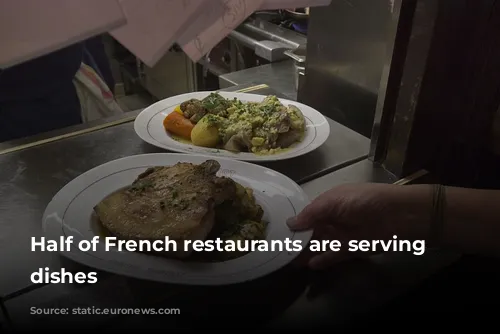Are you a fan of French cuisine? Do you picture yourself enjoying a delicious meal in a quaint bistro? Well, you might be surprised to learn that many restaurants serve dishes prepared with industrial, frozen ingredients! This could be a shock, considering the rich history and prestige of French gastronomy.

The “Fait Maison” Conundrum
While it’s convenient and cheaper to buy pre-made meals, it’s a growing concern for many chefs and food enthusiasts in France. The use of industrially prepared food, often with minimal fresh ingredients, is becoming more common, leading to criticism and concerns about the quality of French cuisine.
Thierry Marx, a two-Michelin-starred chef, highlights this issue, stating that only half of France’s 175,000 restaurants serve truly homemade dishes. He believes that many restaurants suffer because they are competing with establishments that use readily available, and often less expensive, frozen meals without informing their patrons.

A Push for Transparency
To combat this trend and uphold France’s culinary reputation, the French government is stepping in. They are proposing a new law that will require restaurants to clearly indicate whether dishes are homemade or not.
This move aims to empower consumers by providing them with clear information about the origin and preparation of their food. It’s similar to the “fait maison” label introduced in 2014, but this new rule will be compulsory, not optional.

A Label with a History
The original “fait maison” label, launched in 2014, was intended to help diners identify dishes made on site from fresh ingredients. However, it didn’t gain widespread acceptance. Many restaurant owners found the label too flexible and didn’t see the need for it, while consumers didn’t trust it enough.
This led to the creation of other certifications and standards, like the “Quality Restaurant” label and the “Maître restaurateur” label, which promote the use of fresh, homemade ingredients.

A Move Towards “Fait Maison” for All
The new “fait maison” law has received enthusiastic support from Alain Fontaine, head of the French Association for Maître Restaurateurs. He believes this initiative will create jobs and reassure customers about the authenticity of their meals.
The government plans to implement this new rule by 2025, in time for the Paris Olympic Games. This is seen as a way to showcase the best of French gastronomy to the world and attract tourists.

A Step in the Right Direction
The new “fait maison” label is a step towards a more transparent and authentic culinary experience in France. It’s an opportunity for chefs and restaurant owners to reassert their commitment to high-quality, homemade cuisine and for consumers to make informed choices about where they dine.

A French Foodie’s Guide
Here are some helpful tips from a French food enthusiast to help you navigate the world of French dining:
- Beware of overly extensive menus: If you see more than 15 main dishes, it might be a sign of industrial preparation.
- Scrutinize the “basics”: Dishes like duck confit, gratin dauphinois, shepherd’s pie, or chocolate mousse are often prepared by industrial suppliers.
- Consider the seasonality: Menus that don’t change with the seasons may use more frozen products.
- Be mindful of prices: A complete menu that’s too cheap may also be a red flag.
- Don’t hesitate to ask: If you have any doubts, ask your server about the origin and preparation of the dishes.
Ultimately, France has plenty of restaurants offering delicious, freshly prepared meals. Don’t let the possibility of pre-made food deter you from experiencing the real delights of French cuisine. Bon appétit!








